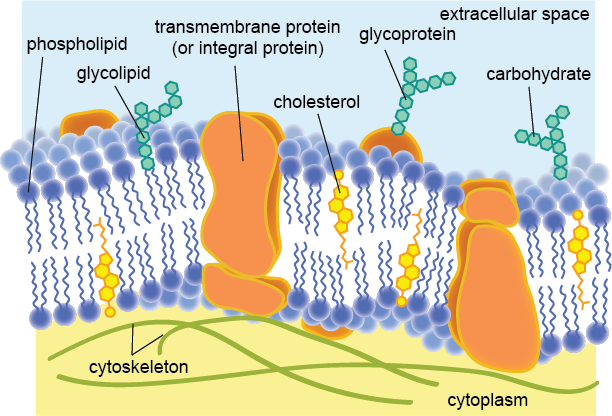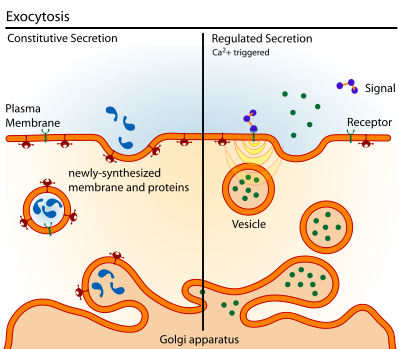The plasma membrane is made almost entirely of protein and lipid,together with a small and variable amount of carbohydrate. This is called the fluid mosaic model, it is described as fluid because the components (lipids and proteins) are on the move and mosaic because the proteins are scattered about in this pattern.
All cells have a plasma/cell membrane
Functions
- Controls what enters and exits the cell to maintain and internal balance called homeostasis
- Provides protection and support for the cell
- Phosphate head is polar (water loving)
- Fatty acid tails non-polar (water fearing)
- Protein embedded in membrane
2.4.2 Explain how the hydrophobic and hydrophilic properties of phospholipids help to maintain the structure of cell membranes.
Phospholipid has a head composed of a glycerol group to which is attached to one ionized phosphate group. This latter part of the molecule has hydrophilic properties (water-loving). Hydrogen bonds form between the phosphate head and the water molecules.
The remainder of the phospholipid consists of two long, fatty acid residues consisting of hydrocarbon chains. These 'tails' have hydrophobic properties (water-hating).
Therefore phospholipid is unusual in being partly hydrophilic and partly hydrophobic.
When more phospholipid is available, the molecules arrange themselves as a bi-layer, with the hydrocarbon tails facing together. In the lipid bi-layer, attractions between the hydrophobic hydrocarbon tails are on the inside which the hydrophilic heads are on the outside. The surrounding water on the outside make a stable and strong barrier.
2.4.3 List the functions of membrane proteins.
Movement of molecules across the plasma membrane of living cells is continuous and heavy. Cells requires the plasma membrane to pass water, respiratory gases and nutrients. Membrane proteins can act as hormone binding sites, electron carriers, pumps for active transport, channels for passive transport and also enzymes.
Glycoprotein is used as an indicator. Cholesterol is used to maintain the fluidity of the membrane, it sits in the hydrophobic region of the plasma membrane.
Channels for transport of metabolites or water
Channel protein: For passage through membrane - each channel allows one specific substance to pass
Pump protein: For active transport across membrane - energy from ATP is used selectively to move one (or two) specific substances across
Enzymes and carriers
Electron carrier proteins: A chain of peripheral and integral proteins that allow electrons to pass across the membrane
Enzymes held in membrane: Catalyse reactions at surface of membrane, within or outside the cell
Active site: The substrate molecule fits here and the reaction then occurs
Receptors, antigens, cell-cell recognition and cell binding sites
Binding protein for attachment of a specific hormone: A signal is then generated that is transmitted inside the cell
Cell-Cell recognition site: Attachment may result in cells binding together.
Binding sites: For antigen-antibody reaction
2.4.4 Define diffusion and osmosis.
Both diffusion and osmosis are types of passive transport. There are a few different things that help define passive transport. Such include: cell uses no energy, molecules move randomly and molecules spread out from an area of high to an area of low.
Diffusion is the random movement of particles from an area of high concentration to an area of low concentration.
Osmosis is the diffusion of water through a selectively permeable membrane
Hypotonic: The solution has a lower concentration of solutes and a high concentration of water than inside the cell.
Hypertonic: The solution has a higher concentration of solutes and a lower concentration of water than inside the cell.
Isotonic: The concentration of solutes in the solution is equal to the concentration of solutes inside the cell.
2.4.5 Explain passive transport across membranes by simple diffusion and facilitated diffusion
Passive transport
Simple diffusion is simply the random of movement until all molecules are evenly spaced (equilibrium is reached)
Facilitated diffusion is the diffusion of specific particles through transport proteins found in the membrane
- Transport proteins are specific - they "select" only certain molecules to cross the membrane
- Transports larger or charged molecules (electrons)
2.4.6 Explain the role of protein pumps and ATP in active transport across membranes.
Active transport is the movement of substances against a concentration gradient (from a region of low concentration to a region of higher concentration) across a plasma membrane. This process requires energy. This energy is provided by mitochondria in the form of ATP and cells performing active transport on a large scale contains numerous mitochondria.
Active transport depends on proteins in the cell membrane to transport specific molecules or ions. These carriers can move.
- One substance in one direction (uniport carriers)
- Two substances in one direction (symport carriers)
- Two substances in opposite direction (antiport carriers)
2.4.7 Explain how vesicles are used to transport materials within a cell between the rough endoplasmic reticulum, Golgi apparatus and plasma membrane.
Protein synthesis occurs at the ribosomes. After proteins have finished synthesis, they are transported to the rough Endoplasic Reticulum (rER) where they can be modified. Golgi Apparatus then further modifies and prepares the protein for secretion. The vesicle transports the modified protein to the plasma membrane where it will perform exocytosis.
2.4.8 Describe how the fluidity of the membrane allows it to change shape, break and re-form during endocytosis and exocytosis.
Cytosis is the process of transport where parts of the plasma membrane form infoldings or outfoldings. This can lead to transporting materials into a cell (endocytosis) or out of a cell (exocytosis).
In endocytosis, there are three methods of infoldings. This includes: phagocytosis, pinocytosis and receptor mediated endocytosis. Phagocytosis is cell eating. Solid substances, sometimes whole organisms, are taken into a cell through infolding of the surface membrane. This is seen in an amoeba and cells such as white blood cells. Pinocytosis is a process similar to phagocytosis, but here the infolding in the membrane are much smaller. Liquids or large micromolecules are taken in through small vesicles through cell drinking. The third process, Receptor mediated endocytosis, is a process which receptors on the surface membrane adhering to specific substrates from the extracellular environment. This is endocytosis with the aid of receptors.
Exocytosis is the reverse process of endocytosis. The vesicles and vacuoles move towards the surface membrane, fuse with it and release their content outside the cell. Though the vesicles will normally go through the process of rER to Golgi apparatus to the plasma membrane.




沒有留言:
張貼留言